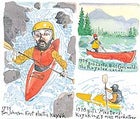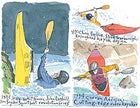THIRTY YEARS AGO, if you wanted to run a river, you steered a 60-pound barge and prayed. But today, a serious boater owns a quiver of vessels, from a Royalex canoe to a rodeo kayak. Here’s a salute to the designers who built the rides.
The Big Idea
Get the behind the gear and technology of the 21st century.


In the late sixties, Los Angeles fireman and amateur paddler Tom Johnson spent more time patching fiberglass than running rivers. Then Johnson and his buddy Don Carmichael, an employee at the plastic-trash-can manufacturer Hollowform, convinced execs to start producing plastic kayaks. Boating was soon transformed: In 1973, Johnson designed the canary-yellow, 13-foot-long River Chaser, and the age of California-style steepcreeking was born.
Tired of watching rocky Appalachian Rivers play Humpty-Dumpty with their canoes, structural engineers Bob Lantz and Bill Griswold journeyed to Warsaw, Indiana, to visit a company that built crude canoe hulls out of a new firm and foamy plastic called Royalex. By 1974, Lantz had founded the Blue Hole Canoe Company, the first business to mass-market durable Royalex rides.
Bill Masters, owner of the fledgling company Perception, became the king of kayak manufacturing in 1978 by designing a rotational molder and oven to mass-produce plastic kayaks. Then he offered a precedent-setting one-year warranty on his boats. By 1998 he was selling 50,000 per year.
In 1979, Nolan Whitesell set out to prove he could do anything a kayaker could do—in an open canoe. He developed an effective whitewater roll, invented inflatable float bags, and became the first canoeist to tackle dozens of Class V-plus rapids. Whitesell’s canoe design, the Piranha, helped: He reshaped and widened a typical hull by three inches for stability in rough water.
Kayaking used to be a 2-D sport—paddlers floated on a river and reacted to its surface currents. But in 1981, Jesse Whittemore and former Olympian Jon Lugbill started slicing bows and sterns underwater in moves dubbed squirts, cartwheels, and blasts. Paddler Jim Snyder got wind of their antics and began designing skinnier boats, which set off the squirt-boat revolution.
With their creation of the Crossfire kayak in 1991, former Olympian Chris Spelius and designer Steve Scarborough touched off the boat-design wars. The Crossfire’s curved ends and shorter length made it turn on a dime. Dagger, Scarborough’s company, carved out a secure place in an industry that had been dominated by Perception for a decade.
And the innovations go on: Corran Addison arrived at California’s 1994 Pacifica Surf Contest with his Fury, a strange new breed of rodeo kayak that had a squarish hull built to plane over the water rather than sit in it. Today, almost every new kayak features his boxier profile, making Addison’s signature moves—air-blunts and air-screws—mandatory components of every pro rodeo boater’s bag of tricks.


